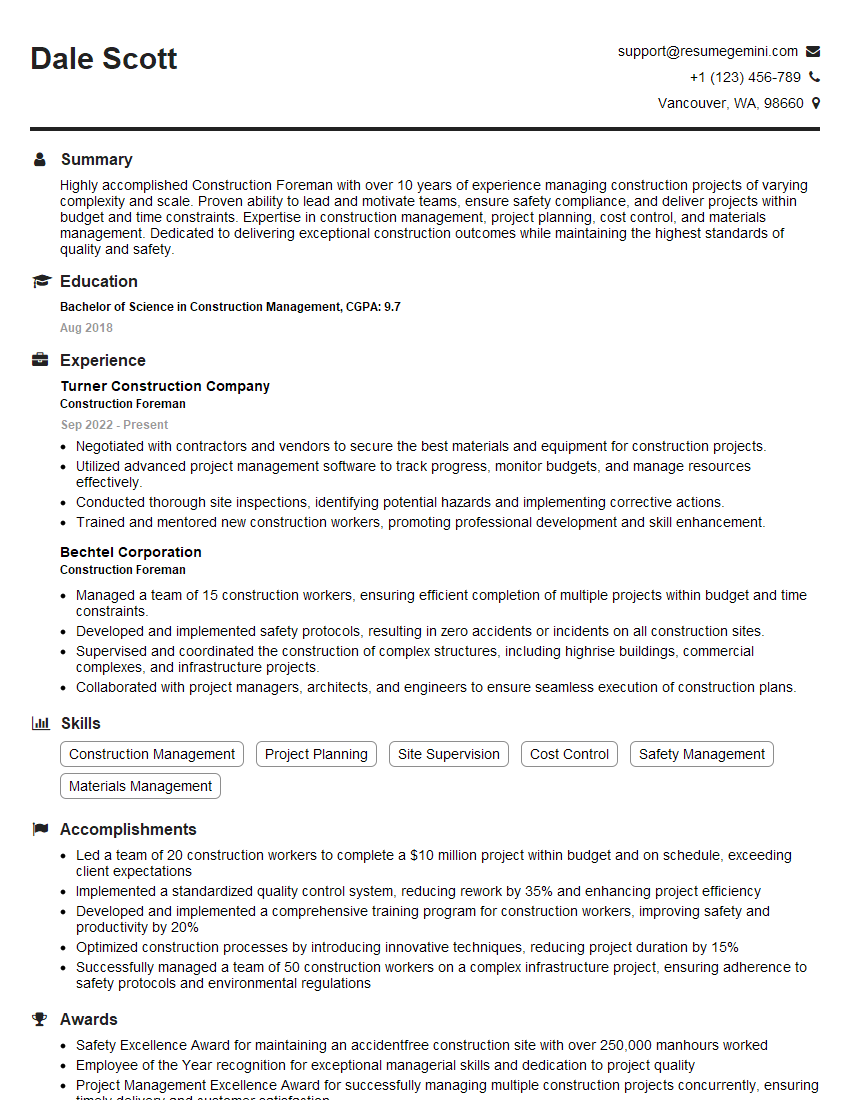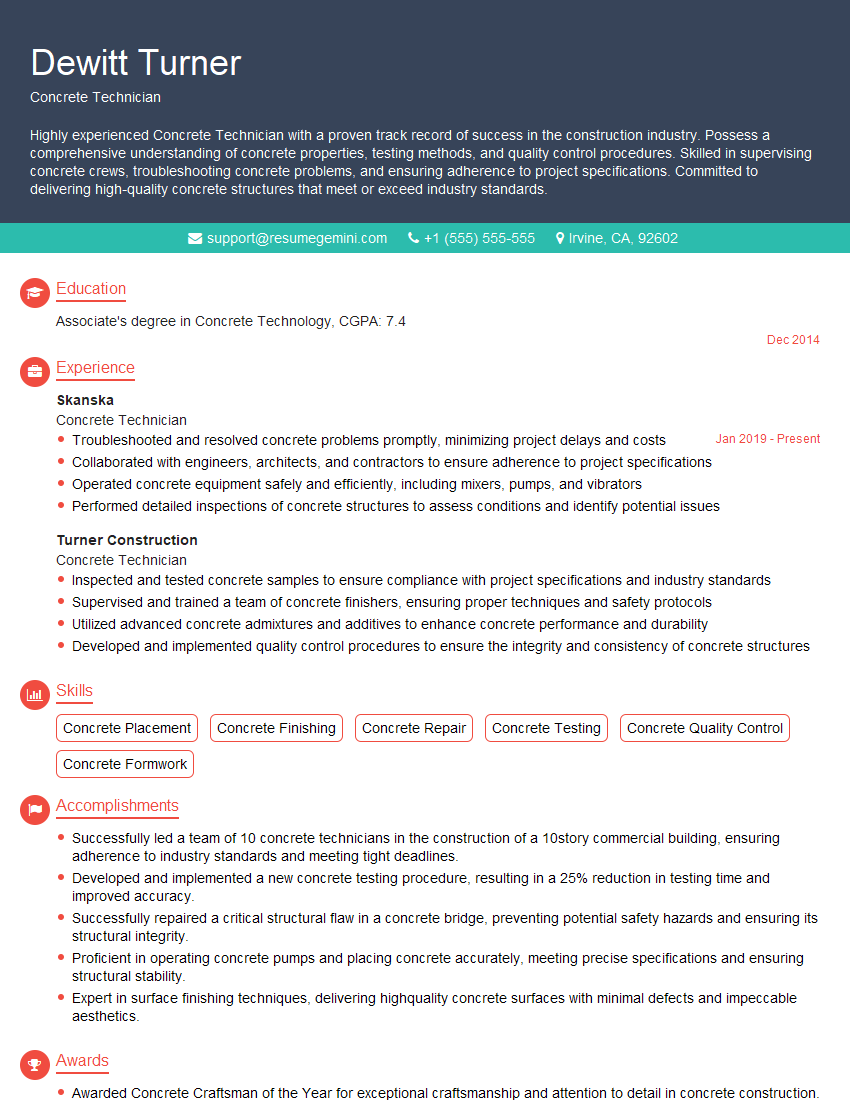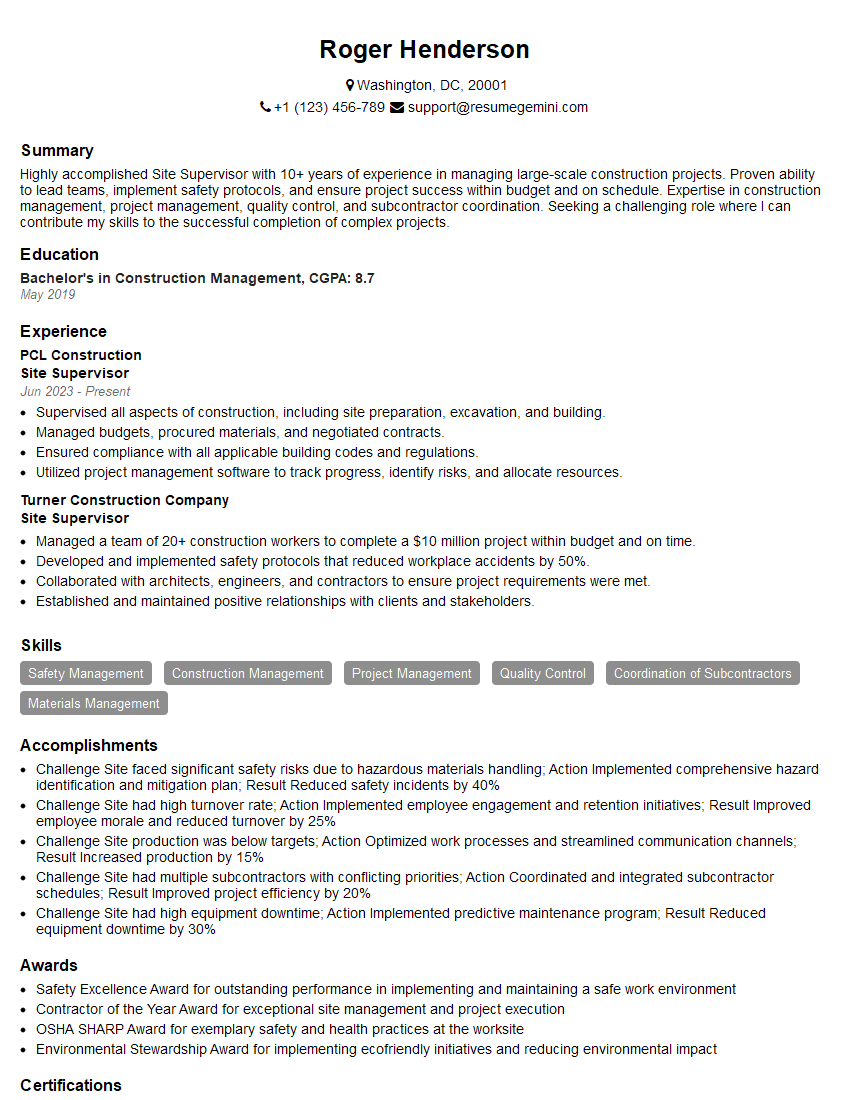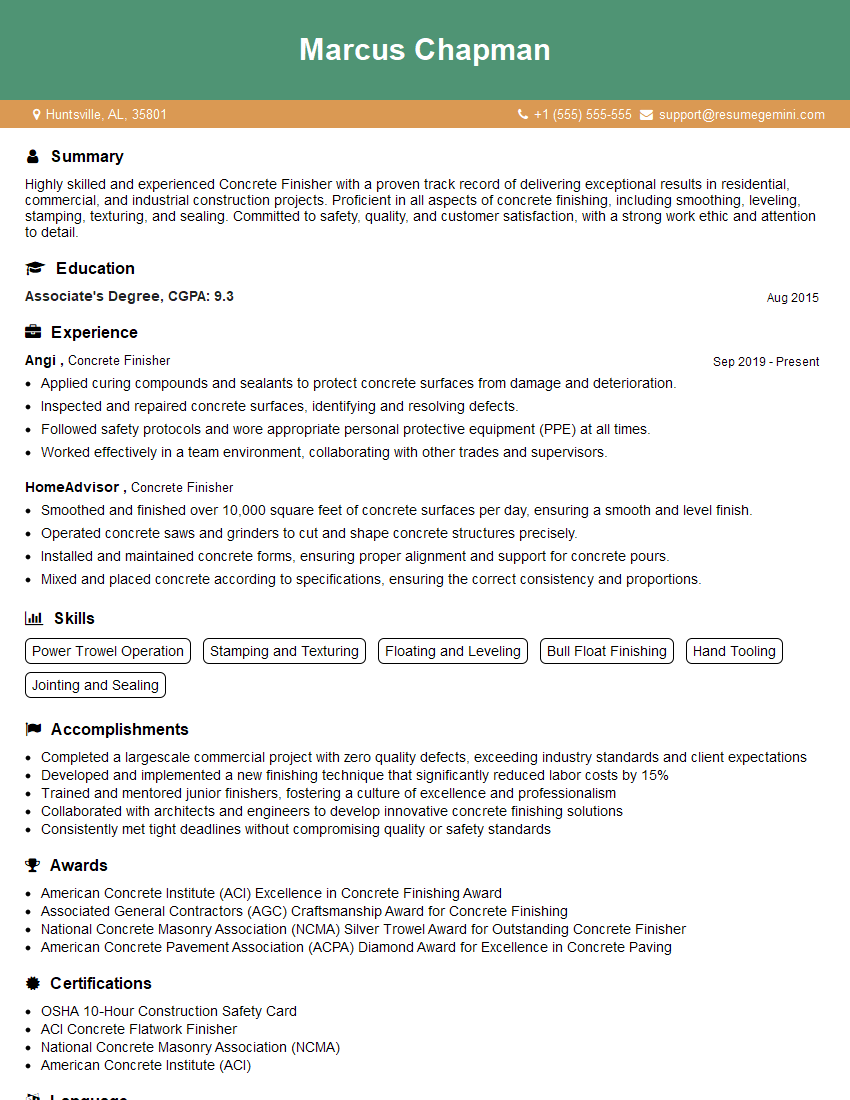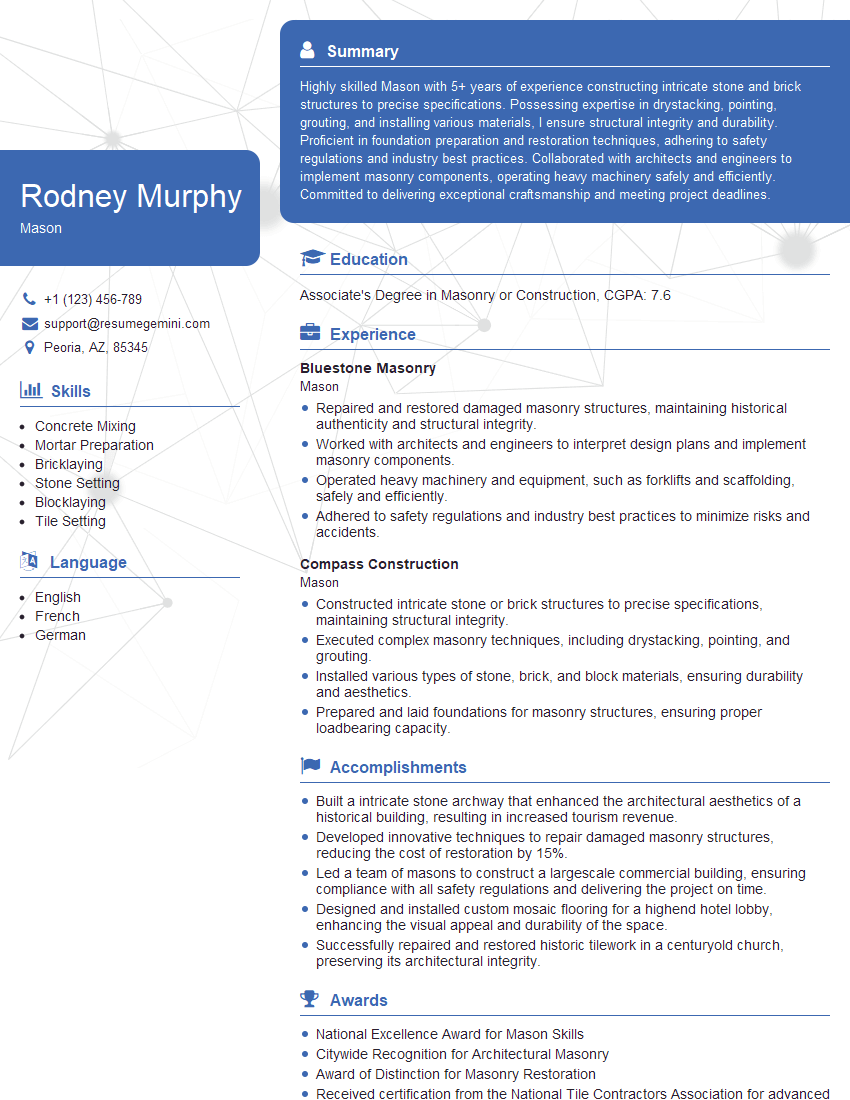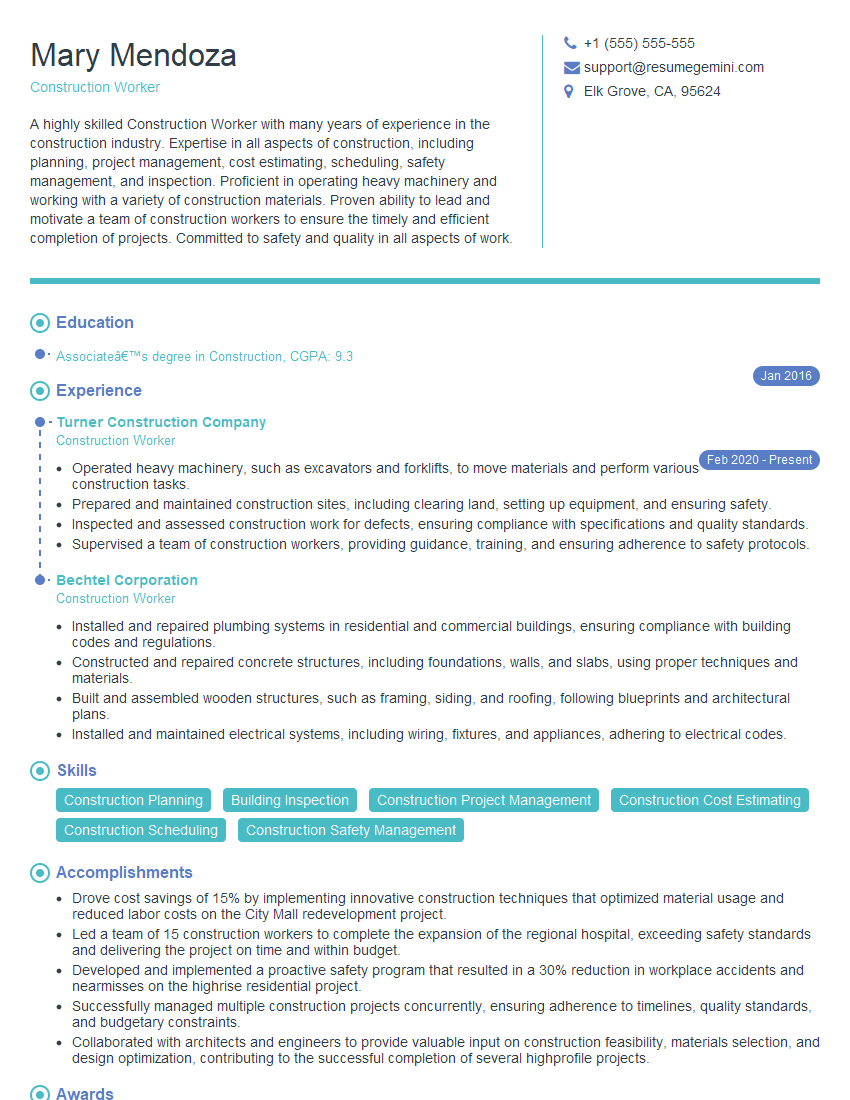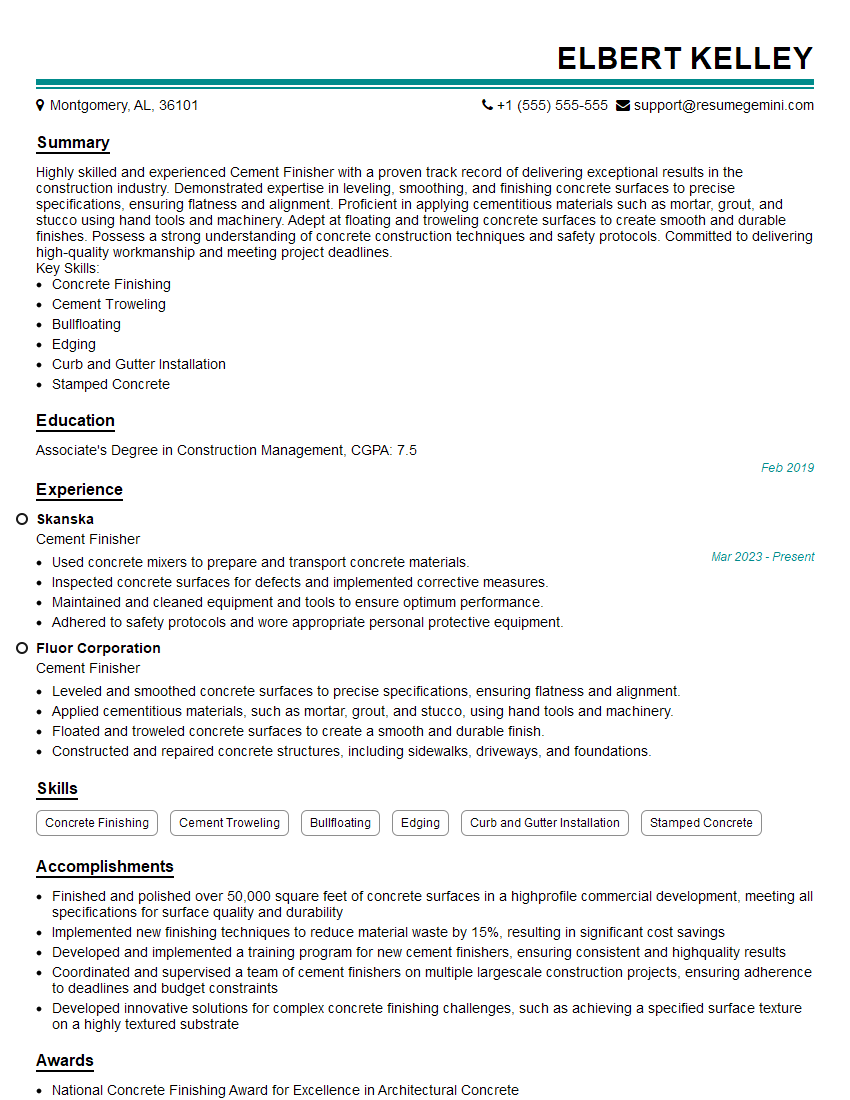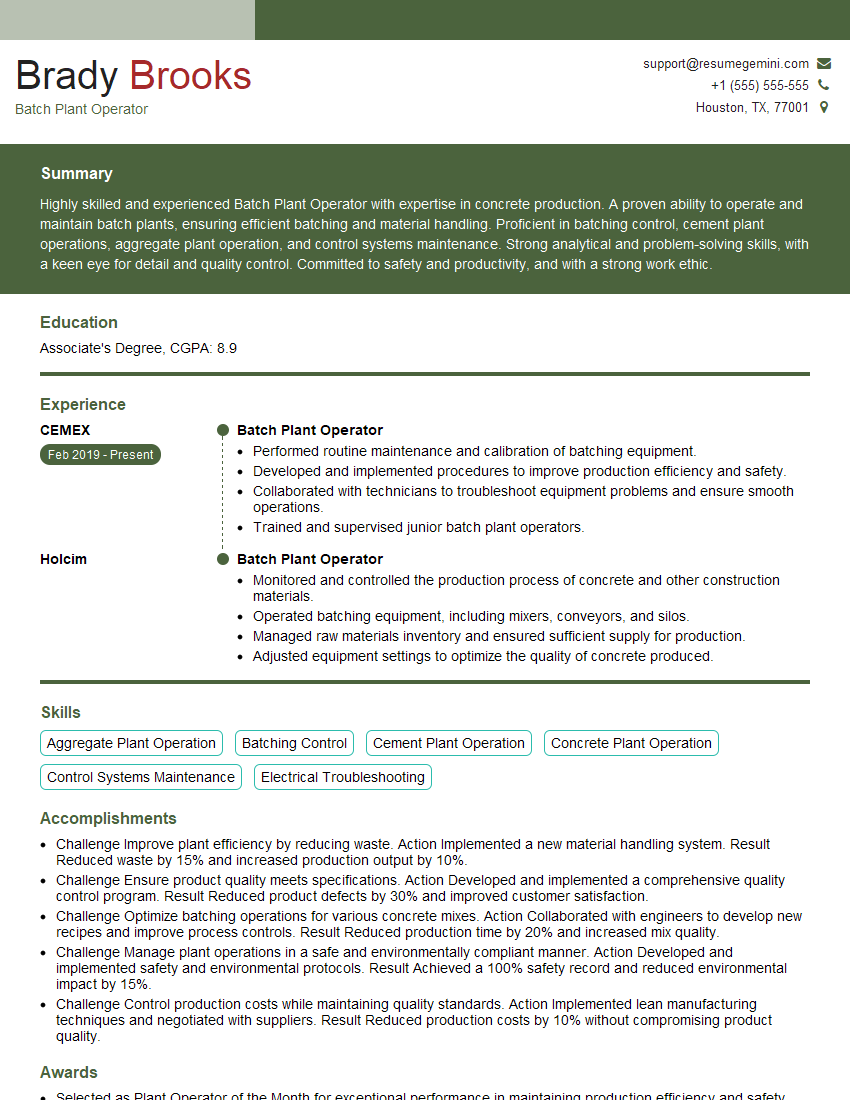Unlock your full potential by mastering the most common Cement Mixing and Placing interview questions. This blog offers a deep dive into the critical topics, ensuring you’re not only prepared to answer but to excel. With these insights, you’ll approach your interview with clarity and confidence.
Questions Asked in Cement Mixing and Placing Interview
Q 1. What are the different types of cement and their applications?
Cement comes in various types, each tailored for specific applications. The most common is Portland cement, a hydraulic cement that sets and hardens through a chemical reaction with water. Its strength and versatility make it suitable for a wide range of projects, from foundations to pavements.
- Ordinary Portland Cement (OPC): The workhorse of the cement world, used in general-purpose concrete applications.
- Rapid Hardening Portland Cement: Sets and gains strength faster than OPC, ideal for projects needing quick turnaround times.
- Low Heat Portland Cement: Generates less heat during hydration, beneficial for massive concrete structures to prevent cracking.
- Sulfate Resisting Portland Cement: Formulated to withstand aggressive sulfate environments, commonly found in soils and seawater.
- High Alumina Cement: Offers exceptionally high early strength but is more susceptible to chemical attack.
The choice of cement depends heavily on the project requirements. For example, in a large dam, low-heat cement is essential to control cracking due to heat generation. Conversely, for rapid repairs, rapid-hardening cement is the preferred choice.
Q 2. Explain the process of batching cement mix according to specifications.
Batching a cement mix involves precisely measuring and combining the ingredients – cement, aggregates (sand and gravel), water, and sometimes admixtures – according to the specified mix design. This design dictates the proportions of each material to achieve the desired concrete properties (strength, workability, durability).
The process typically involves:
- Weighing ingredients: Using calibrated scales to precisely measure the mass of each component. This is crucial for consistency.
- Mixing ingredients: A concrete mixer, either a batch mixer (mixing all ingredients simultaneously) or a continuous mixer (continuously adding and mixing ingredients), thoroughly combines the materials.
- Quality control checks: Testing the mix for slump (workability) and air content to ensure it meets the specifications. A slump test measures the consistency of the concrete, while the air content test helps determine its durability.
For example, a common mix design might specify a ratio of 1:2:4 (cement:sand:gravel) by volume or by weight for strength requirements. Any deviation from the specified proportions can significantly affect the final concrete quality.
Q 3. How do you ensure the proper water-cement ratio in a mix?
The water-cement ratio is critical in determining concrete strength and durability. A lower water-cement ratio leads to stronger, more durable concrete because less water means more cement-aggregate bonding.
Ensuring the correct ratio involves:
- Precise measurement: Accurately measuring the amount of water and cement using calibrated instruments is essential.
- Mix design adherence: Following the pre-determined water-cement ratio specified in the mix design is crucial. This ratio is usually expressed as a weight ratio (e.g., 0.45, meaning 0.45 kg of water per kg of cement).
- Adjustments: In some cases, slight adjustments might be necessary based on the aggregate moisture content. If the aggregates are damp, less water might be required, and vice versa.
- Monitoring and testing: Regularly checking the slump test results can provide an indirect indication of the water content and consistency of the mix.
Imagine building a brick wall – you wouldn’t use too much mortar (cement paste); similarly, too much water weakens the concrete. Therefore maintaining the right proportion is of paramount importance.
Q 4. What are the signs of a poorly mixed batch of concrete?
A poorly mixed batch of concrete exhibits several tell-tale signs:
- Uneven color and texture: The mix should be homogenous; streaks of different colors or textures indicate incomplete mixing.
- Low slump: A stiff, unworkable mix suggests insufficient water or poor mixing.
- High slump: An overly runny mix points to excess water, compromising strength and durability.
- Segregation: Separation of components (e.g., larger aggregates settling at the bottom) is a clear sign of inadequate mixing.
- Bleeding: Excess water rising to the surface, leaving behind a weak layer, shows problems with mixing and water-cement ratio.
- Lumps and voids: Clumps of unmixed cement or significant air pockets indicate poor mixing action.
Observing these signs during placement allows for immediate corrective action, preventing defects in the hardened concrete structure. A simple visual inspection is often sufficient to detect these problems.
Q 5. Describe the methods of placing concrete in different situations (e.g., formwork, slabs, columns).
Concrete placement methods vary based on the application:
- Formwork: For columns, walls, and beams, concrete is poured into pre-built forms made of wood, steel, or other materials. Vibration is usually necessary to consolidate the concrete and remove air bubbles.
- Slabs: Concrete is poured and spread evenly to the desired thickness using methods like bulldozers or paving machines, often with vibrating screeds to level the surface and consolidate the mix.
- Columns: Concrete is usually placed using tremie pipes or concrete pumps to ensure continuous flow and minimize segregation. The pipes are inserted into the column formwork from the top and filled with concrete. Consolidation involves internal vibrators.
- Other methods: Pumping allows for concrete placement in hard-to-reach areas, while shotcreting (pneumatically projecting concrete) is used for specialized applications like linings and repairs.
The chosen method is crucial for ensuring proper consolidation and preventing segregation. For example, using tremie pipes is essential when pouring high columns to minimize segregation issues caused by free fall.
Q 6. What safety measures should be taken during cement mixing and placing?
Safety is paramount throughout the cement mixing and placing process. Key measures include:
- Personal Protective Equipment (PPE): Workers must wear safety helmets, safety glasses, gloves, and boots to protect against injuries from falling objects, splashes, and sharp edges.
- Respiratory protection: Dust masks are crucial to prevent inhalation of cement dust, which can cause respiratory problems.
- Proper handling of materials: Lifting heavy bags of cement and other materials requires appropriate lifting techniques and potentially mechanical aids to prevent back injuries.
- Fall protection: Working at heights requires appropriate fall protection measures, including harnesses and guardrails.
- Safe machinery operation: Proper training and adherence to safety protocols are essential for operating mixers, pumps, and other equipment.
- Wet work areas: Keeping work areas clean and wet helps to reduce dust and prevents the risk of slips and falls.
A comprehensive safety plan, including regular training and risk assessments, is necessary for every project.
Q 7. How do you prevent segregation and bleeding in concrete?
Segregation (separation of components) and bleeding (water rising to the surface) are common problems that can weaken concrete. Prevention involves:
- Proper mixing: Thorough mixing ensures a homogenous mix, preventing segregation.
- Controlled placement: Careful pouring and minimal free fall reduce segregation. Using methods like tremie pipes for high placements is crucial.
- Vibration: Consolidating concrete using vibrators removes air pockets and helps distribute aggregates evenly, preventing segregation and promoting homogeneity.
- Optimum water-cement ratio: Avoid using excessive water, a major contributor to bleeding.
- Admixtures: Superplasticizers can improve workability without increasing the water content, reducing both bleeding and segregation.
- Layered placement: For large pours, placing concrete in layers and consolidating each layer thoroughly minimizes segregation.
Imagine making a cake – you wouldn’t just dump all the ingredients in and hope for the best! Similarly, careful placement and consolidation of concrete are crucial to prevent segregation and bleeding, ensuring a strong and durable final product.
Q 8. Explain the importance of vibration during concrete placement.
Vibration during concrete placement is crucial for removing entrapped air and consolidating the concrete mix, leading to a denser, stronger, and more durable final product. Imagine trying to build a sandcastle with air pockets – it would be weak and crumble easily. Similarly, air voids in concrete reduce its strength and increase its susceptibility to cracking and deterioration. Vibration helps the concrete particles settle closer together, filling those voids and enhancing its overall performance. This is achieved using internal vibrators (vibrating rods inserted into the concrete) or external vibrators (vibrating tables or forms). The choice depends on the size and shape of the element being cast.
Q 9. What are the common problems encountered during concrete placement and their solutions?
Several common problems arise during concrete placement. Segregation, where the coarser aggregates separate from the finer cement paste, can occur if the concrete is dropped from too high or vibrated excessively. This leads to a weaker structure with inconsistent properties. The solution is careful placement and controlled vibration. Bleeding, the upward movement of water to the surface, can also occur, leaving a weak surface layer. This is often addressed by using a well-graded mix and avoiding excessive vibration. Honeycombing, the presence of large voids in the concrete, can result from insufficient consolidation. This is solved by thorough vibration and proper placement techniques. Lastly, cold joints form when fresh concrete is placed against hardened concrete without proper bonding, resulting in a weak section. Overcoming this requires ensuring the previous pour is still workable before placing new concrete. Effective joint preparation is crucial.
Q 10. How do you ensure proper consolidation of concrete?
Proper consolidation ensures that the concrete is dense and free of voids, maximizing its strength and durability. This is achieved through a combination of techniques. Effective vibration is key, as previously discussed. However, the method and duration of vibration are critical. Over-vibration can lead to segregation, while under-vibration leaves voids. The correct vibration time is determined through experience and observation – the concrete should appear smooth and free of air bubbles. The placement process itself plays a vital role; the concrete should be placed in layers, and each layer should be thoroughly consolidated before the next is added. Using the right equipment, such as a suitable vibrator, is also important. Finally, the mix design itself influences consolidation; a well-graded mix with the correct water-cement ratio will consolidate more easily.
Q 11. Describe the process of finishing concrete surfaces.
Finishing concrete surfaces involves a series of steps aimed at creating a smooth, level, and aesthetically pleasing surface. These steps vary depending on the intended use and desired finish. Common methods include screeding, which creates a level surface using a long, straight edge; floating, which smooths the surface using a bull float; and troweling, which produces a finer finish with a steel trowel. Different types of trowels can achieve various textures, from smooth to broomed. For some projects, additional steps such as edging or grooving may be required. The process demands skill and precision; the timing is crucial, as the concrete must be worked while still workable yet before it starts to set. The temperature and humidity conditions also influence the finishing process.
Q 12. What is the significance of curing concrete?
Curing is the process of maintaining the moisture content and temperature of the concrete after placement to allow for proper hydration of the cement. Hydration is the chemical reaction between cement and water that leads to hardening and strength gain. Without proper curing, the hydration process is incomplete, resulting in a weaker, more porous, and less durable concrete structure. Think of it like baking a cake – you need to leave it in the oven for the right amount of time to ensure it’s cooked through. Similarly, concrete needs proper curing to reach its full potential strength and durability. Inadequate curing leads to increased permeability, reduced strength, and increased susceptibility to cracking and deterioration. The effect on long-term performance is very significant.
Q 13. What are different curing methods for concrete?
Several curing methods are employed depending on the project’s requirements and environmental conditions. Water curing, the simplest method, involves keeping the concrete surface continuously wet. This can be achieved through ponding, spraying, or covering with wet burlap. Membrane curing uses waterproof sheets or compounds to retain moisture. Steam curing accelerates the hydration process by exposing concrete to steam in a controlled environment, often used for precast concrete elements. Chemical curing involves applying a curing compound that seals the surface, preventing moisture loss. The choice of method depends on factors such as temperature, humidity, and the duration of the curing period. Each method has its advantages and disadvantages concerning cost, effectiveness, and suitability for different applications.
Q 14. How do you determine the slump of concrete?
The slump test is a simple method for determining the consistency or workability of fresh concrete. It measures the slump, or the vertical drop of a cone of concrete after the cone is removed. A slump cone, a truncated metal cone of specific dimensions, is filled with fresh concrete in three layers, each compacted with a standard number of pokes with a metal rod. After the cone is carefully removed, the vertical drop of the concrete is measured. The slump value is expressed in inches or millimeters. A higher slump indicates a more workable concrete, but excessively high slump can lead to segregation. Conversely, a low slump might suggest poor workability. Slump testing is a critical quality control measure, ensuring the concrete’s consistency meets the specifications.
Q 15. What is the significance of slump test?
The slump test is a crucial indicator of the workability of fresh concrete. Workability refers to how easily the concrete can be placed and consolidated into the formwork without segregation (separation of components like aggregates and cement paste). The test measures the consistency of the concrete mix. A slump cone, a metal cone with specific dimensions, is filled with fresh concrete, then carefully removed. The slump, or the amount the concrete settles, is measured in inches or millimeters.
Significance: A slump value gives us an immediate understanding of the water-cement ratio. A higher slump indicates a higher water content, leading to increased workability but potentially reduced strength and durability. Conversely, a low slump might suggest a stiff mix that’s difficult to place and consolidate properly. Target slump values are specified on project plans and depend on factors like the type of structure and placement methods. For instance, a higher slump might be suitable for heavily reinforced sections, while a lower slump might be preferred for mass concrete pours to prevent segregation.
In practice: Imagine pouring concrete into a complex foundation. A slump test performed regularly on each batch ensures the mix is consistent and workable, preventing delays and ensuring the finished product meets quality standards.
Career Expert Tips:
- Ace those interviews! Prepare effectively by reviewing the Top 50 Most Common Interview Questions on ResumeGemini.
- Navigate your job search with confidence! Explore a wide range of Career Tips on ResumeGemini. Learn about common challenges and recommendations to overcome them.
- Craft the perfect resume! Master the Art of Resume Writing with ResumeGemini’s guide. Showcase your unique qualifications and achievements effectively.
- Don’t miss out on holiday savings! Build your dream resume with ResumeGemini’s ATS optimized templates.
Q 16. How do you handle concrete in hot or cold weather?
Concrete placement in extreme temperatures requires careful planning and execution. Both hot and cold weather affect the hydration process (the chemical reaction between cement and water that leads to hardening), potentially compromising the concrete’s strength and durability.
- Hot Weather: Increased evaporation leads to rapid water loss, potentially causing surface cracking, reduced strength, and increased shrinkage. To mitigate this, we might use methods like:
- Adding ice to the mixing water.
- Using a retarder admixture (explained further in the next answer) to slow down the setting time.
- Protecting the concrete with curing compounds to prevent moisture loss.
- Placing concrete at cooler times of the day (early mornings or evenings).
- Cold Weather: Low temperatures slow down or even halt the hydration process, leading to prolonged setting times and reduced early-age strength. We address this with:
- Heating the mixing water.
- Using an accelerator admixture (explained further in the next answer) to speed up the setting time.
- Insulating the formwork.
- Using calcium chloride or other suitable de-icing agents to ensure proper curing.
- Protecting the concrete from freezing temperatures by covering it with blankets or tarpaulins.
Real-world Example: During a large-scale highway project in winter, we used heated water, accelerated admixtures, and insulated forms to ensure the concrete cured properly despite the sub-zero temperatures, preventing any damage to the newly constructed pavement.
Q 17. What are the common admixtures used in concrete and their functions?
Admixtures are chemical compounds added to concrete to modify its properties. They enhance workability, strength, durability, and setting time.
- Water reducers/Superplasticizers: These reduce the water needed for a given workability, leading to higher strength and durability. Think of them as making the concrete mix more ‘flowy’ with less water.
- Retarders: These slow down the setting time, which is useful in hot weather or for large concrete pours.
- Accelerators: These speed up the setting time, particularly helpful in cold weather.
- Air-entraining admixtures: These incorporate tiny air bubbles into the mix, enhancing the concrete’s resistance to freeze-thaw cycles and improving its workability. These bubbles act as tiny cushions, preventing the damage caused by ice expansion.
- Waterproofing admixtures: Increase the concrete’s resistance to water penetration.
- Corrosion inhibitors: Help protect reinforcing steel from corrosion.
Example: On a bridge project, we used a high-range water reducer to achieve a very fluid concrete mix that was easily pumped into the complex formwork, resulting in a strong and durable structure.
Q 18. How do you identify and address issues with air entrainment in concrete?
Air entrainment is the intentional incorporation of air bubbles into the concrete mix. While beneficial when controlled, excessive air can weaken the concrete and negatively affect its strength and durability. Insufficient air entrainment in areas prone to freeze-thaw cycles can lead to damage.
Identification: The air content is measured using a pressure meter. Visual inspection can also help; excessive air might show up as a noticeably porous or bubbly texture. Testing the concrete’s resistance to freeze-thaw cycles is also a key indicator.
Addressing issues:
- Excessive air: This usually indicates an issue with the mixing process or the amount of air-entraining admixture used. Recalibrating the mixing process, reducing the admixture, or adjusting the water content can resolve this.
- Insufficient air: In freeze-thaw prone areas, insufficient air is a serious concern. Adding the appropriate amount of air-entraining admixture or revising the mix design are crucial steps.
Example: During a pavement project, we noticed excessive air in some batches. By carefully reviewing the mixing procedures and the dosage of air-entraining admixture, we identified and corrected the issue, ensuring the pavement met the required strength and durability standards.
Q 19. Explain the importance of quality control in concrete work.
Quality control is paramount in concrete work. It ensures the final product meets the design specifications and intended performance. A failure in concrete can have severe structural and safety implications.
Importance: Quality control involves implementing stringent procedures throughout the process, from material selection and batching to placement and curing. This includes regular testing of materials, monitoring the mixing process, performing slump tests, and ensuring proper curing practices. Documentation is critical, with all test results, material certificates, and procedures meticulously recorded.
Examples of QC measures:
- Regular testing of aggregates, cement, and admixtures.
- Ensuring proper batching procedures are followed.
- Performing slump tests and air content tests on each batch.
- Monitoring concrete placement and consolidation.
- Implementing appropriate curing methods.
- Conducting compressive strength tests on cured samples.
Consequences of poor QC: Without rigorous QC, we risk reduced strength, increased cracking, premature deterioration, and potential structural failure, leading to costly repairs, delays, and safety hazards.
Q 20. Describe your experience with different types of formwork systems.
My experience encompasses a variety of formwork systems, each with its strengths and weaknesses.
- Timber formwork: This is a traditional and versatile system, suitable for a wide range of applications. However, it requires skilled labor, is relatively labor-intensive, and may not be cost-effective for large-scale projects.
- Steel formwork: More durable and reusable than timber, steel formwork is ideal for repetitive elements and complex geometries. It’s also more robust and can withstand higher pressures but requires specialized equipment and handling.
- Aluminum formwork: Lightweight and easy to handle, aluminum formwork is commonly used for smaller projects or where access is restricted. It’s less durable than steel and may be more expensive initially.
- Prefabricated formwork: This system uses pre-cast or pre-assembled formwork panels, significantly reducing construction time and labor costs. It is particularly efficient for repetitive elements like walls and columns.
- Slipforming: This method uses continuously moving forms to create long, vertical elements such as walls and bridge piers. It is highly productive but requires specialized equipment and experienced personnel.
Example: On a high-rise building project, we employed a combination of steel and prefabricated formwork systems to optimize efficiency and cost-effectiveness. The steel formwork was ideal for the columns and core walls, while prefabricated panels were used for the repetitive floor slabs.
Q 21. How do you manage concrete placement in confined spaces?
Concrete placement in confined spaces presents unique challenges. Access is often limited, making it difficult to maneuver equipment and properly consolidate the concrete.
Strategies for confined spaces:
- Smaller equipment: Utilize smaller pumps, conveyors, and vibrators that can navigate tight spaces.
- Tremie method: A tremie is a long, vertical pipe used to place concrete underwater or in deep, narrow shafts. It minimizes segregation and minimizes air entrainment.
- Manual placement: In extremely confined areas, manual placement might be necessary, requiring careful attention to consolidation to avoid voids and segregation.
- Proper planning: Meticulous planning is crucial, ensuring the concrete can be delivered, placed, and consolidated efficiently within the constraints of the space. This includes developing a detailed plan of how the concrete will be moved and placed.
- Safety precautions: Confined space work requires strict adherence to safety regulations, including appropriate ventilation, fall protection, and respiratory protection.
Example: During the repair of a deteriorated underground section of a water pipe, we employed the tremie method for precise and effective placement of concrete, ensuring the structural integrity of the repair.
Q 22. Explain your experience with pumping concrete.
My experience with pumping concrete spans over 10 years, encompassing a wide range of projects from high-rise buildings to large-scale infrastructure developments. I’m proficient in operating various types of concrete pumps, including boom pumps, line pumps, and trailer pumps, and I understand the importance of selecting the appropriate pump based on the project’s specific requirements, such as concrete slump, placement distance, and accessibility constraints. I’ve successfully managed pumping operations in challenging environments, ensuring consistent concrete flow and minimizing downtime. For instance, on a recent high-rise project, we encountered a particularly tight site with limited access, necessitating the strategic deployment of a smaller, more maneuverable line pump. Effective communication with the pumping crew, site engineers, and the ready-mix supplier was critical in ensuring smooth and efficient concrete placement. This careful planning prevented delays and ensured the highest quality concrete placement in difficult conditions.
Furthermore, I possess in-depth knowledge of pump maintenance and troubleshooting, which has proven invaluable in preventing costly delays. Regular inspections and proactive maintenance—like monitoring pressure, lubricating moving parts and ensuring proper cleaning—are essential to prevent breakdowns. I have experience in diagnosing and resolving various pump-related issues on the spot, preventing significant delays. For example, I once quickly identified a blockage in the pump line caused by hardened concrete, enabling swift action to clear the blockage and resume pumping within minimal downtime.
Q 23. What are the different types of concrete finishes and their applications?
Concrete finishes are crucial for both aesthetic appeal and structural integrity. The choice of finish depends on the intended use and the desired look. Some common types include:
- Broomed finish: Created by brushing the surface with a stiff broom, this provides a textured, slip-resistant surface ideal for driveways, patios, and walkways.
- Float finish: Achieved by using a long-handled tool called a float to smooth the surface, resulting in a relatively smooth, even finish often seen in sidewalks and interior slabs.
- Power trowel finish: Using a power trowel creates a very smooth, highly polished surface suitable for interior floors where aesthetics are prioritized, such as in warehouses or commercial spaces.
- Exposed aggregate finish: This involves washing away the cement paste from the surface to expose the aggregate, creating a unique and visually appealing finish commonly used for decorative pavements and architectural features.
- Stamped concrete: Using textured stamps to create patterns and designs on the concrete surface, this is a popular choice for driveways, patios, and walkways, adding visual interest.
The selection of the appropriate finish requires considering factors such as the intended use of the concrete, the desired aesthetic, and the overall project budget. For example, a broomed finish is more cost-effective than a power trowel finish, but it may not be suitable for high-traffic areas where a very smooth surface is required.
Q 24. How do you calculate the required amount of concrete for a project?
Calculating the required amount of concrete involves determining the volume of the structure and accounting for waste. This is typically done using the following steps:
- Determine the dimensions: Measure the length, width, and depth of the concrete structure in feet or meters.
- Calculate the volume: Multiply the length, width, and depth to obtain the volume in cubic feet or cubic meters (e.g., Length x Width x Depth = Volume).
- Account for waste: Add a percentage for waste, typically ranging from 5% to 10%, depending on the complexity of the structure and the placement method. More complex pours often have higher waste factors.
- Convert to cubic yards: Since concrete is usually ordered in cubic yards, convert the volume to cubic yards (1 cubic yard = 27 cubic feet or 0.765 cubic meters).
For example, for a slab measuring 10 ft x 15 ft x 0.5 ft (depth), the volume is 75 cubic feet. Adding a 10% waste factor yields 82.5 cubic feet. Converting to cubic yards (82.5 cubic feet / 27 cubic feet/cubic yard) results in approximately 3.1 cubic yards of concrete needed. Remember to always round up to ensure sufficient concrete is available.
Q 25. Explain your experience working with different types of aggregates.
My experience working with aggregates encompasses various types, including gravel, crushed stone, sand, and recycled aggregates. Each aggregate type has unique properties affecting the concrete’s final properties. For example, the grading of the aggregate impacts the workability of the mix—well-graded aggregates lead to a better mix. I understand the importance of selecting aggregates that meet specific project requirements concerning strength, durability, and aesthetic considerations.
I’ve worked with various aggregate sources and have experience in quality control, ensuring that the aggregates meet the specified size, shape, and cleanliness standards. Using substandard aggregates can drastically impact the strength and durability of the final concrete. On one project, we discovered a batch of aggregates with excessive fines (very small particles), which compromised the workability of the concrete. We promptly addressed the issue by replacing the contaminated aggregate, thereby preventing significant issues with the finished structure.
Q 26. How do you ensure the proper compaction of concrete?
Proper concrete compaction is essential for achieving the desired strength and durability. This is achieved by eliminating air pockets and ensuring the concrete is dense and homogenous. Common methods include:
- Vibration: Using internal vibrators (needle vibrators) or external vibrators (plate vibrators) to consolidate the concrete, eliminating trapped air. Internal vibrators are used for larger placements, while external vibrators are suitable for thinner slabs. The duration and intensity of vibration must be carefully controlled to avoid segregation.
- Rodding: Manually consolidating the concrete by repeatedly inserting a steel rod into the mixture, particularly effective for smaller pours.
- Tamping: Using a tamping tool to compact the concrete, mainly for less critical applications.
The choice of compaction method depends on the size and type of the concrete structure. Over-vibration can lead to segregation, where the larger aggregate separates from the cement paste, while insufficient vibration leaves air voids, weakening the structure. Careful monitoring and experienced judgment are crucial for effective concrete compaction. This is a crucial aspect of my expertise, ensuring quality projects and minimizing defects.
Q 27. How do you handle unexpected issues during concrete placement?
Unexpected issues during concrete placement are common, and handling them efficiently requires experience and quick thinking. Some common issues include:
- Slump variations: If the concrete slump is too high or low, it can affect the workability and strength. I address this by adjusting the water content (if possible), using admixtures, or contacting the ready-mix supplier to rectify the issue.
- Segregation: If the concrete segregates (the aggregate and cement separate), this results in a weakened structure. Careful handling, proper vibration, and prompt adjustment of the mix design can mitigate this issue.
- Cold weather concreting: Low temperatures can affect the hydration process of the cement, resulting in slow strength gain. Using admixtures, heating the concrete, or protecting the placed concrete are common solutions.
- Equipment malfunction: Pump failures or other equipment malfunctions necessitate quick problem-solving, often involving contacting maintenance personnel or procuring replacement equipment.
My approach to handling unexpected issues involves a combination of thorough planning, rapid problem assessment, and effective communication with the project team. A proactive approach, including regular quality checks and meticulous supervision, can prevent many issues, but being prepared to react efficiently to unforeseen circumstances is equally important. My ability to adapt to changing circumstances and troubleshoot problems quickly makes me an asset in demanding concrete placement projects.
Q 28. Describe your experience working with various concrete specifications.
I have extensive experience working with a wide range of concrete specifications, including those outlined in ASTM (American Society for Testing and Materials) standards and other relevant codes. I understand the implications of different strength classes, durability requirements, and mix designs. My knowledge encompasses various specifications for different applications, from high-performance concrete for demanding structures to more standard mixes for general construction.
Working with these specifications involves understanding the required compressive strength, slump, air content, and other critical properties. I ensure that the concrete supplier adheres to the specified mix design and that the placed concrete meets the required quality standards. I’m proficient in interpreting test results and using them to adjust the placement process if necessary. For example, if the compressive strength is below the specified value, we must investigate the possible causes and implement corrective actions—like checking the aggregate quality, adjusting the mix, or reviewing the curing process—to ensure the structure’s integrity. My attention to detail and comprehensive understanding of concrete specifications guarantee the construction of high-quality and durable structures.
Key Topics to Learn for Cement Mixing and Placing Interview
- Cement Properties & Types: Understanding different cement types (Portland, blended, etc.), their properties (strength, setting time, workability), and how these affect the mixing process.
- Mix Design & Ratios: Calculating accurate cement, aggregate, water, and admixture ratios based on project specifications and desired concrete properties. Practical application: Understanding the impact of varying water-cement ratios on strength and workability.
- Mixing Methods & Equipment: Familiarity with various mixing techniques (batching, continuous), equipment operation (mixers, pumps, conveyors), and their maintenance. Practical application: Troubleshooting common mixing equipment problems.
- Placement Techniques & Considerations: Understanding proper placement methods for different applications (pouring, pumping, vibration), handling and preventing segregation and ensuring proper consolidation. Practical application: Knowing how to adjust placement techniques based on weather conditions and concrete consistency.
- Quality Control & Testing: Knowledge of standard testing procedures (slump test, air content test, compressive strength testing) and their importance in ensuring quality concrete. Practical application: Interpreting test results and identifying potential problems.
- Safety Procedures & Regulations: Understanding and adhering to all relevant safety regulations, including personal protective equipment (PPE) usage and hazard identification. Practical application: Recognizing and mitigating potential safety risks on a job site.
- Environmental Considerations: Understanding the environmental impact of cement production and concrete placement, including waste management and sustainable practices. Practical application: Implementing environmentally friendly practices on the job site.
Next Steps
Mastering cement mixing and placing is crucial for career advancement in the construction industry, opening doors to supervisory roles and higher earning potential. A strong resume is your key to unlocking these opportunities. Creating an ATS-friendly resume, optimized for applicant tracking systems, significantly increases your chances of getting your application noticed. ResumeGemini is a trusted resource that can help you build a professional and impactful resume, tailored to highlight your skills and experience in cement mixing and placing. Examples of resumes tailored to this field are available through ResumeGemini to guide your resume creation process. Take the next step towards your successful career today!
Explore more articles
Users Rating of Our Blogs
Share Your Experience
We value your feedback! Please rate our content and share your thoughts (optional).
What Readers Say About Our Blog
Hello,
We found issues with your domain’s email setup that may be sending your messages to spam or blocking them completely. InboxShield Mini shows you how to fix it in minutes — no tech skills required.
Scan your domain now for details: https://inboxshield-mini.com/
— Adam @ InboxShield Mini
Reply STOP to unsubscribe
Hi, are you owner of interviewgemini.com? What if I told you I could help you find extra time in your schedule, reconnect with leads you didn’t even realize you missed, and bring in more “I want to work with you” conversations, without increasing your ad spend or hiring a full-time employee?
All with a flexible, budget-friendly service that could easily pay for itself. Sounds good?
Would it be nice to jump on a quick 10-minute call so I can show you exactly how we make this work?
Best,
Hapei
Marketing Director
Hey, I know you’re the owner of interviewgemini.com. I’ll be quick.
Fundraising for your business is tough and time-consuming. We make it easier by guaranteeing two private investor meetings each month, for six months. No demos, no pitch events – just direct introductions to active investors matched to your startup.
If youR17;re raising, this could help you build real momentum. Want me to send more info?
Hi, I represent an SEO company that specialises in getting you AI citations and higher rankings on Google. I’d like to offer you a 100% free SEO audit for your website. Would you be interested?
Hi, I represent an SEO company that specialises in getting you AI citations and higher rankings on Google. I’d like to offer you a 100% free SEO audit for your website. Would you be interested?
good
